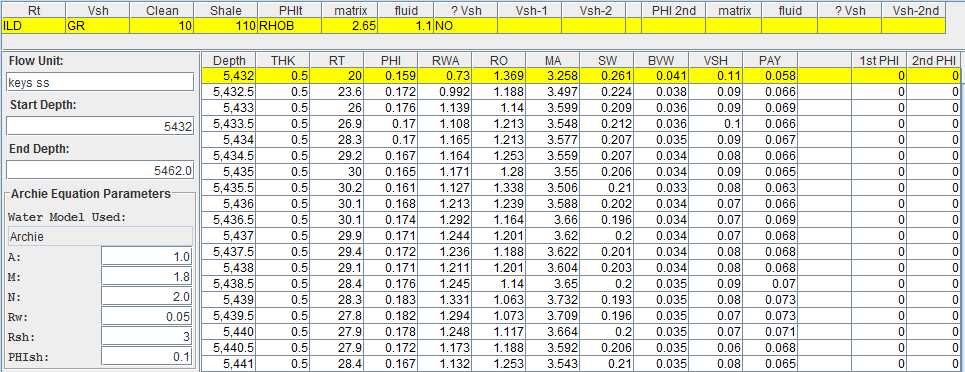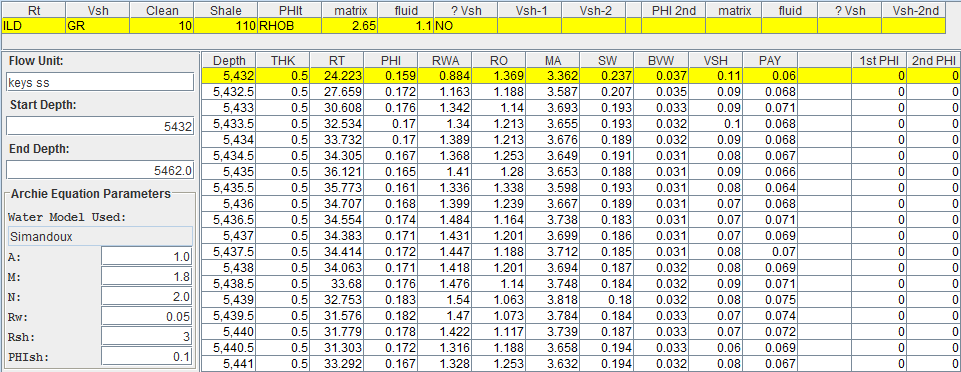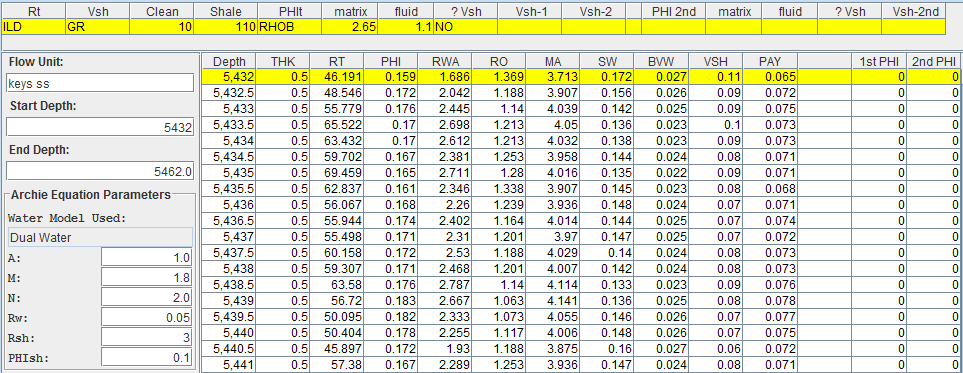

|
HELP: PfEFFER-java |
 |

The Sw Model menu lets you choose between the Archie water saturation model (the default) and two shaly sand models, the Simandoux model and the Dual-water model. These options will be demonstrated using the Keys ss worksheet. PfEFFER determines which model is currently in effect by checking the contents of "Water Model Used:" text field, which reads Archie whenever a new worksheet is created. The Archie model assumes that column RT contains true resistivity log data, the measured bulk resistivity. You switch to one of the shaly sand models by selecting the appropriate entry from the Sw Model menu:

The values of the parameters displayed in the dialog box are those found in the appropriate cells on the current worksheet, Archie parameters for A, m, n, and Rw, Archie parameter Rsh (shale resistivity), and Archie parameter Phish (shale porosity), employed only by the Dual-water model. Changing the value of a parameter on the dialog box changes the corresponding value on the worksheet. If one of the cells on the worksheet is initially empty, then the corresponding text box on the dialog box will initially be empty as well. You must supply all the relevant parameters for a given model before calculations can proceed.
The Iteration settings are fixed at Maximum iterations of 100 and Maximum change of 0.0001 for the shaly sand models, which both use an iterative approach to solve the relevant equations:
Both shaly sand models can be written in the form
a*Swn + b*Sw + c = 0
For the Simandoux model,
a = Co = φm/(A*Rw)
b = Csh = Vsh/Rsh
c = -Ct = -1/Rt
and for the Dual-water model,
a = 1
b = -W = -[Sb*(1-A*Rw/Rb)]
c = -Ish = -A*Rw/(Rt* φtm)
and note that "a" here is distinct from the Archie parameter, denoted "A" above). This polynomial equation can be solved iteratively using Newton’s method, yielding the following iterative equation for Sw:
Sw(k+1) = Swk - (a*Swkn + b*Swk + c)/(n*a*Swkn-1+b)
where the subscript k is the iteration index. This iteration can be implemented in Excel using a self-referential formula for each cell containing Sw. The code initializes the Sw values using the quadratic equation, i.e., assuming that n = 2. It then sets the formula for each Sw cell to the right- hand side of the equation above, where the Swk value is in fact a reference to the cell itself. To resolve this circular reference, PfEFFER employs Excel’s built-in iterative capabilities, turning on iteration prior to displaying the dialog box shown above.

As a consequence of the change in resistivity values in column RT, the Sw values in column SW will also change, so that they match the Sws values to the right. Also, "Water Model Used:" text field will change to display Simandoux. Note: The Parameter Rsh must have a value greater than 0.0 before the Simandoux Water Model is selected.

The resistivities and water saturations in the home area will change to reflect the Dual-water model, rather than the Simandoux model. The shaly sand computations attempt to "correct" the resistivities to match the assumptions of the Archie model by removing the influence of the shale fraction. Note: The Parameters Rsh & PHIsh must have a value greater than 0.0 before the Dual Water Model is selected.